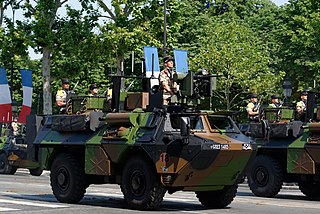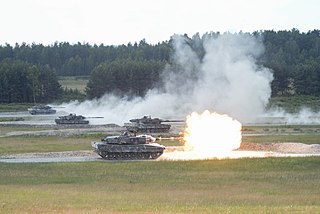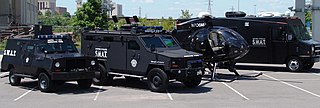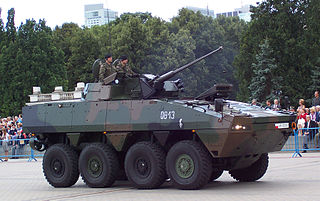
An armoured fighting vehicle (AFV) is an armed combat vehicle protected by armour, generally combining operational mobility with offensive and defensive capabilities. AFVs can be wheeled or tracked. Tanks, armoured cars, assault guns/armoured self-propelled guns, infantry fighting vehicles and armoured personnel carriers (APC) are all examples of AFVs.

A military armoredcar is a lightweight wheeled armored fighting vehicle, historically employed for reconnaissance, internal security, armed escort, and other subordinate battlefield tasks. With the gradual decline of mounted cavalry, armored cars were developed for carrying out duties used to be assigned to light cavalry. Following the invention of the tank, the armored car remained popular due to its faster speed, comparatively simplified maintenance and low production cost. It also found favor with several colonial armies as a cheaper weapon for use in underdeveloped regions. During World War II, most armored cars were engineered for reconnaissance and passive observation, while others were devoted to communications tasks. Some equipped with heavier armament could even substitute for tracked combat vehicles in favorable conditions—such as pursuit or flanking maneuvers during the North African Campaign.

The High Mobility Multipurpose Wheeled Vehicle is a family of light, four-wheel drive, military trucks and utility vehicles produced by AM General. It has largely supplanted the roles previously performed by the original jeep, and others such as the Vietnam War-era M151 jeep, the M561 "Gama Goat", their M718A1 and M792 ambulance versions, the Commercial Utility Cargo Vehicle, and other light trucks. Primarily used by the United States military, it is also used by numerous other countries and organizations and even in civilian adaptations. The Humvee saw widespread use in the Gulf War of 1991, where it navigated the treacherous desert terrain; this usage helped to inspire civilian Hummer versions. The vehicle's original unarmored design was later seen to be inadequate. The vehicle was found to be particularly vulnerable to improvised explosive devices in the Iraq War. The U.S. hastily up-armored select models and replaced front-line units with the MRAP. The U.S. military sought to replace the vehicle in front-line service under the Joint Light Tactical Vehicle (JLTV) program. In 2015 the Oshkosh L-ATV was selected for production.

The Patria Pasi is a Finnish-made six-wheeled armoured personnel carrier (APC) originally designed for Finnish Defence Forces. The first version was produced in 1983 and serial production began in 1984. It was designed to operate with ease of use, simple structure and low-cost maintenance. The basic appearance and configuration of Patria Pasi is similar to most wheeled APCs. The XA-180 and XA-185 versions are fully amphibious while the XA-203 is not.

The Véhicule de l'Avant Blindé or VAB is a French armoured personnel carrier and support vehicle designed and manufactured by Renault Trucks Defense. It entered service in 1976 and around 5,000 were produced. It has seen combat in various conflicts in Africa, Asia as well as Europe and has also been exported to more than 15 countries.

The Combat Vehicle Reconnaissance (Tracked), abbreviated CVR(T), is a family of armoured fighting vehicles (AFV)s developed in the 1960s and is in service with the British Army and others throughout the world. They are small, highly mobile, air-transportable armoured vehicles, originally designed to replace the Alvis Saladin armoured car.

The BRDM-2 is an amphibious armoured scout car used by states that were part of the Soviet Union and its allies. It was also known under the designations BTR-40PB, BTR-40P-2 and GAZ 41-08. This vehicle, like many other Soviet designs, has been exported extensively and is in use in at least 38 countries. It was intended to replace the older BRDM-1, and has improved amphibious capabilities and better armament compared to its predecessor.

Armoured warfare or armored warfare, is the use of armored fighting vehicles in modern warfare. It is a major component of modern methods of war. The premise of armoured warfare rests on the ability of troops to penetrate conventional defensive lines through use of manoeuvre by armoured units.

A SWAT vehicle, also known as an armoured rescue vehicle, a vehicle used by police tactical units to respond to incidents. These are often non-military armored vehicles which offer protection to the passengers and can additionally be used to transport specialized equipment such as weapons and breaching tools.

The BTR-40 is a Soviet non-amphibious, wheeled armoured personnel carrier and reconnaissance vehicle. It is often referred to as the Sorokovka in Soviet service. It is also the first mass-produced Soviet APC. It was eventually replaced in the APC role by the BTR-152 and in the scout car role by the BRDM-1.

The Marmon-Herrington Armoured Car was a series of armoured vehicles that were produced in South Africa and adopted by the British Army during the Second World War. RAF Armoured Car companies possessed them, but seem never to have used them in action, making greater use of Rolls Royce Armoured Cars and other types.

The Cadillac Gage Commando, frequently denoted as the M706 in U.S. military service, is an American armored car designed to be amphibious. It was engineered by Cadillac Gage specifically for the United States Military Police Corps during the Vietnam War as an armed convoy escort vehicle. The Commando was one of the first vehicles to combine the traditionally separate roles of an armored personnel carrier and a conventional armored car, much like the Soviet BTR-40. Its notable height, amphibious capability, and waterproofed engine allowed American crews to fight effectively in the jungles of Vietnam by observing their opponents over thick vegetation and fording the country's deep rivers.
A huge number of M113 Armored Personnel Carrier variants have been created, ranging from infantry carriers to nuclear missile carriers. The M113 armored personnel carrier has become one of the most prolific armored vehicles of the second half of the 20th century, and continues to serve with armies around the world in many roles.

The KTO Rosomak is an 8×8 multi-role military vehicle produced by Rosomak S.A. in Siemianowice Śląskie, a Polish Armaments Group company. The vehicle is a licensed variant of Patria's armored modular vehicle.

An improvised fighting vehicle is an ad hoc combat vehicle resulting from modified or upgraded civilian or military non-combat vehicle, often constructed and employed by civilian insurgents, terrorists, rebels, guerrillas, resistance movements, criminal organizations or other forms of non-state militias and irregular armies. Such modifications usually consist of grafting armour plating and fixed weapons onto a utility vehicle or pickup truck.

The Wolf Armoured Vehicle is an armoured personnel carrier, used mainly by the Israeli Defence Force. It was created to provide a better handling and better protected armoured vehicle than the M113 (Bardelas). The Wolf is a heavily armoured crew carrier, manufactured by the company Carmor. It combines a commercial truck's speed and maneuverability and APC-like armour, qualities necessary for low-intensity confrontation. The Wolf's chassis is based on a Ford F-550 truck, and is equipped with a 6-litre V8 engine capable of reaching 325 horsepower. The engine is combined with a 5-speed automatic transmission, which drives all four wheels, making this a four-by-four.

Improvised vehicle armour is protective materials added to a mobile platform such as a car, truck, or tank in an irregular and extemporized fashion, using available materials. Typically, improvised armour is added in the field and it was not originally part of the design, an official up-armour kit, nor centrally planned and distributed. Improvised armour is used to protect occupants from small arms, crew-served weapons and artillery fire, and mines. Improvised additions have included metal plate, scrap metal, sandbags, concrete, wood, and, since at least the 2000s, Kevlar. These materials vary widely in their ballistic protection.

An armoured personnel carrier (APC) is a broad type of armoured military vehicle designed to transport personnel and equipment in combat zones. Since World War I, APCs have become a very common piece of military equipment around the world.

The Peugeot armoured car was a four-wheeled armoured vehicle based on a commercial Peugeot truck that was quickly developed by the French in 1914 for use during the First World War.

The Tigr is a Russian 4×4 multipurpose all-terrain infantry mobility vehicle manufactured by Military Industrial Company, first delivered to the Russian army in 2006.




























